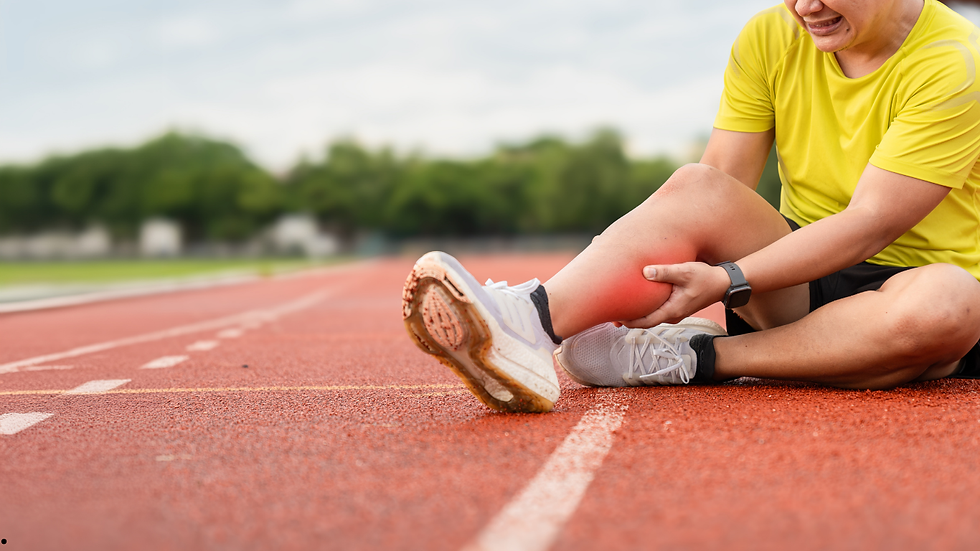Sports Injuries: Types, Symptoms, Causes & Treatment
- mash media
- Sep 10
- 3 min read
Athletes and fitness freaks facing sports injuries is quite a common sight. Sports Injuries may occur due to accidents, poor techniques, or insufficient warm-ups, if you’re a professional player or a casual sportsman. Below is a detailed description of the types of sports injuries along with symptoms, causes and treatment. Dr Hatif is experts in sports injuries

Types of Sports Injuries
1. Sprains and Strains
Sprains happen when ligaments are stretched or torn, most often in the ankles, wrists and knees.
Strains refer to the overstretching or tearing of muscles or tendons, often in the hamstrings or back.
2. Fractures (Broken Bones)
Frequent in contact sports such as football and basketball.
Fractures are simple (closed) or compound (open, breaking through the skin).
3. Dislocations
Occurs when bones are pressed out of their normal alignment.
Frequent in shoulders, fingers, and knees.
4. Tendinitis (Overuse Injuries)
Inflammation of tendons due to repetitive movements.
Examples include tennis elbow and jumper’s knee.
5. Concussions
Brain injuries caused by a direct blow to the head.
Symptoms include headaches, dizziness, and confusion.
6. Shin Splints
Pain along the shin bone, often due to excessive running.
7. Rotator Cuff Injuries
Affects the shoulder due to repetitive overhead motions.
8. Achilles Tendon Rupture
A severe injury affecting the back of the ankle.
Common in runners and basketball players.
Symptoms of Sports Injuries
1. Pain and Tenderness
The most obvious sign of an injury.
Can be sharp, dull, or throbbing.
2. Swelling and Bruising
Occurs due to inflammation or internal bleeding.
May worsen within a few hours of injury.
3. Limited Range of Motion
Difficulty in moving the affected area.
4. Weakness and Instability
Feeling of unsteadiness in joints.
5. Deformity
Visible displacement or abnormal shape of a joint or bone.
6. Numbness and Tingling
Occurs when nerves are affected.
7. Headache and Dizziness (For Concussions)
May indicate a brain injury requiring urgent care.
Causes of Sports Injuries
1. Lack of Warm-up and Stretching
Muscles and joints need preparation before intense activity.
2. Overuse and Repetitive Movements
Continuous stress on a particular muscle or joint leads to injuries.
3. Poor Technique and Form
Incorrect posture or movement increases the risk of injury.
4. Improper Equipment and Gear
Worn-out shoes or inadequate protective gear can cause harm.
5. Sudden Impacts and Falls
Contact sports like rugby and soccer have a higher injury risk.
6. Weak Muscles and Joints
Lack of strength training can make joints vulnerable to injury.
7. Playing Through Pain
Ignoring minor injuries can worsen them over time.
Treatment for Sports Injuries
1. R.I.C.E. Method (For Minor Injuries)
Rest: Do not use the injured area.
Ice: Apply ice packs to minimize swelling.
Compression: Keep it raised at or above the waist.
Elevation: To help minimize swelling, keep the injured area above the level of the heart.
2. Pain Management
Over-the-counter pain relievers like ibuprofen or acetaminophen.
3. Physical Therapy
Helps restore strength and flexibility.
Specific exercises target injured areas.
4. Bracing and Support
Knee braces, ankle supports, or slings can aid recovery.
5. Surgery (For Severe Injuries)
Needed for fractures, ligament tears, or dislocations.
6. Chiropractic Care and Massage Therapy
Can relieve muscle stiffness and improve mobility.
7. Stem Cell and PRP Therapy
Advanced treatments for faster tissue regeneration.
Preventing Sports Injuries
1. Proper Warm-Up and Cool-Down
Always stretch before and after exercising.
2. Strength Training and Conditioning
Strengthens muscles and joints, reducing injury risk.
3. Wearing the Right Gear
Use quality footwear and protective gear.
4. Practicing Good Technique
Take coaching lessons to improve form and movements.
5. Rest and Recovery
Avoid overtraining and give muscles time to heal.
6. Stay Hydrated and Maintain Nutrition
Proper hydration and diet aid in muscle function and recovery.
7. Regular Health Check-Ups
Helps identify weak areas prone to injury.
When to See a Doctor?
If pain lasts more than a few days.
Bloody and swelling and bruise don’t seem to get better.
Needing to rest the injured area.
Symptoms of a concussion such as dizziness or memory loss.
Dislocation or intense pain in the injured area.
Dr Hatif Siddiqui offer expert diagnosis and treatment for all types of sports injuries.
Conclusion
Sports injuries can be a part of life for almost anyone, but with some information, preventing and treating those injuries is possible. Knowledge of the symptoms, causes, and treatment helps in faster rehabilitation. Visit Dr Hatif if you get injured in sports for the best treatment and prevention or Book Consultation now.





Comments